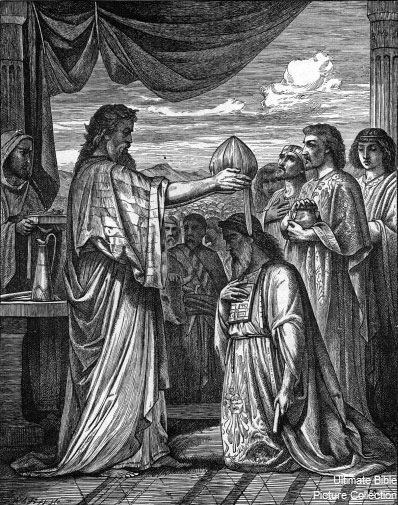May
20
2009

Leaving Wilderness Behind
In Through New Eyes, James Jordan notes that the wilderness was Havilah, the place mentioned in Genesis 2 that was rich in raw materials. Israel stripped Egypt of her gold, then plundered the desolate places of hidden wealth. She came out of the desert with a High Priest clothed in gems, and a new generation of soldiers born of God’s threshing floor.
The manna began to fall just after the Hebrews’ victory over Pharaoh. As with Jacob, the Lord was faithful to provide for His chosen one. But perhaps, in covering the ground, there is also the idea of a firmament (this might sound strange to some readers, but I have found the concept is a frequent one). The wilderness is the place of the humble bread of priesthood, displayed in obedience to God. It was the next generation that would drink the wine of Canaan after obedience under Joshua.
A Memorial
The Lord commanded that some manna be put into the Ark as a memorial. Symbolising manna, the white stone is a memorial of faithful priesthood. Joshua’s crossing of the Jordan was memorialised by large, engraved, white stones.
Continue reading
Comments Off | tags: Ark of the Covenant, Atonement, bdellium, Cain, Crucifixion, Ezekiel, Haman, Havilah, Herod, High Priest, James Jordan, Table of Showbread, Talmud, Urim and Thummim, White stone, Zechariah | posted in Biblical Theology, The Last Days
May
17
2009
Furnishing the New House
Zechariah’s night visions move God’s furniture around. As we saw, the instructions for the Tabernacle furniture align it with the Creation Week. And the Creation Week corresponds with the seven Feasts. Zechariah’s visions follow the Creation and Feast patterns, but the Tabernacle furniture has been shifted around all over the place.
Now, you will probably ask how eight visions can align with seven days or seven feasts. The answer is that it takes the two visions in chapter 5 to reflect the Day of Atonement. Thus:
Continue reading
1 comment | tags: bdellium, Lampstand, Manna, Meredith Kline, Revelation, White stone, Zechariah | posted in Biblical Theology, The Last Days
May
14
2009
Why do we put one-eyed, colour-blind pencil pushers in charge of the kaleidoscope?
The white stone mentioned in Revelation 2:17 was always a mystery to me. There are plenty of commentators who make lame suggestions as to its meaning (they sound a bit like a student making up answers during an exam!), but James Jordan got me thinking about it along the lines of its subtle use in the Old Testament. I intend to cover this in a few posts, and consequently may ramble even a little more than usual, but everything is connected in the Bible’s symbol language. This is a bit of a journey, but I am sure we will find it rewarding. Oh, and you will need to switch off your modernistic mind and use your imagination. You know, that thing you only use when you read or watch fiction? You can use it to understand the Bible as well. I know, scholars most often don’t. To cover their inability to make much sense of texts such as the one we are about to inhale, they pretend the writings are a bit primitive. Why do we put one-eyed, colour-blind pencil pushers in charge of the kaleidoscope?
Continue reading
7 comments | tags: High Priest, James Jordan, Modernism, Satan, Tabernacle, Typology, White stone, Zechariah | posted in Biblical Theology, The Restoration Era


























